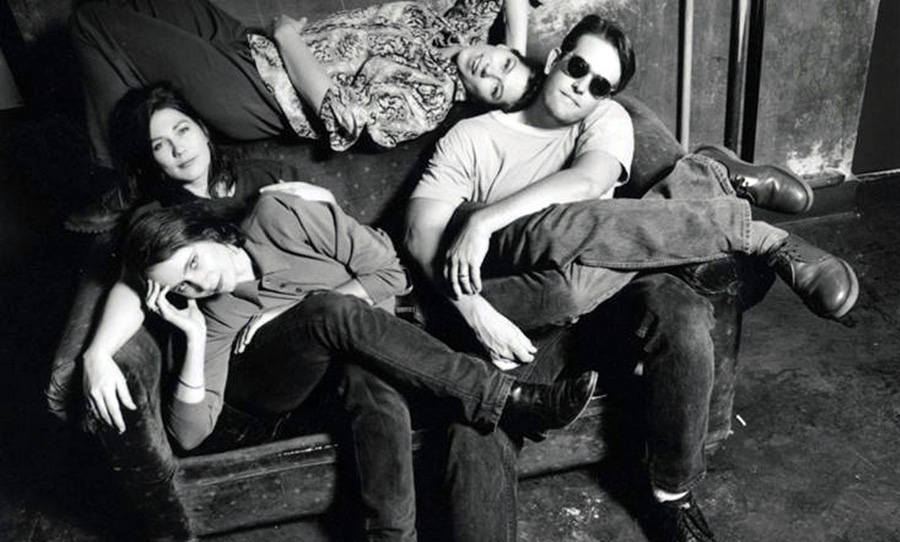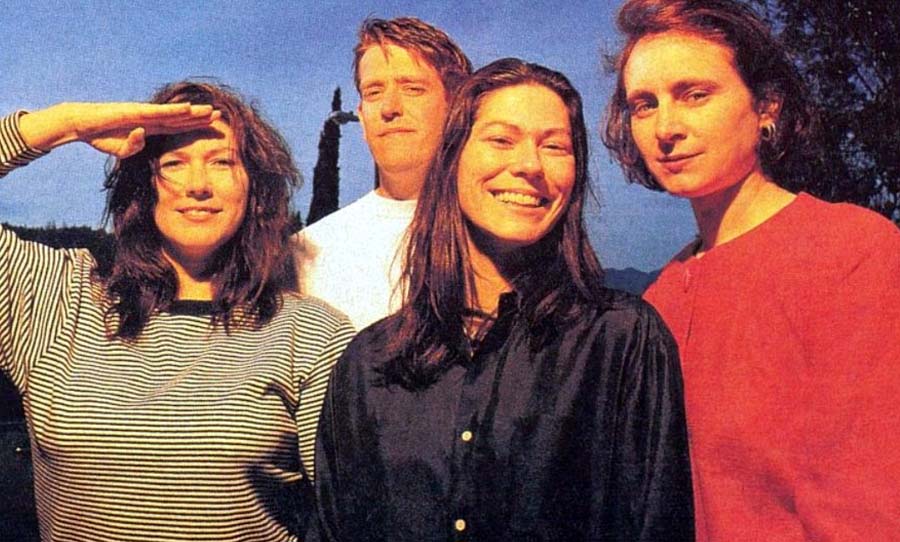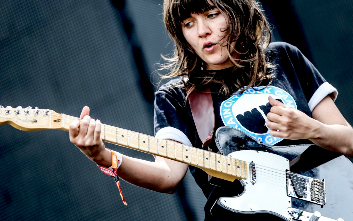From squalls of fuzz to running a sewing machine through a Marshall stack, we delve into The Breeders’ 1993 noise-pop pocket symphony, Last Splash and how one of the landmarks of 90s alternative music was crafted.
Being unceremoniously ejected from your band via fax would leave a bitter taste in anyone’s mouth. Yet Kim Deal’s response to the dissolution of the Pixies was simple. She created a Platinum-selling noise-pop masterpiece – Last Splash.
Convening the second incarnation of side-project The Breeders and aided by veteran 4AD producer Mark Freegard, Deal created alternative rock’s very own pocket symphony. While the influence of the Pixies’ classic run of albums has grown in the ensuing years, the fact of the matter is this: at the close of 1993, The Breeders’ Last Splash eclipsed anything the Pixies had ever achieved.

Creative differences
As an upbeat and unassuming Pixies bassist, the sweetly spoken Kim Deal had always been a fan favourite. However, her creative contributions within the Pixies had greatly diminished towards the end of her 7-year tenure. With a dramatic musical statement expected after the group parted ways, Kim opted to employ The Breeders, a group which had formerly started as a side project with Throwing Muses’ Tanya Donelly.
As Tanya had since exited to project to focus on her own project Belly, a new line-up was convened. Kim’s sister Kelly Deal was recruited to provide guitar parts and angelic vocal harmonies. Forming the group’s rhythm section was ex-Ultra Vivid Scene bassist Josephine Wiggs, a holdover from the original line-up, and young drummer Jim MacPherson. Complementing the group’s live roster violinist Carrie Bradley would also contribute instrumental and vocal parts during recording.
While the exuberant Deal was a media darling, few had anticipated she was a studio mastermind. After touring alongside Nirvana on behest of long-time fan Kurt Cobain, The Breeders cut a series of demos at Cro-Magnon Studios in Dayton, Ohio before travelling to San Francisco to finish the job during the winter of 1993.
Recorded primarily at Coast Recorders, songs were meticulously recorded, scrapped, revised and reworked. A three-week session turned into a grinding four months. Burgeoning hard drug habits were also at play, perhaps contributing to Kim attacking the recording sessions with manic creative energy and relentless perfectionism.
Last Splash was audacious, irreverent and beguilingly warm. The recording was tethered by few, if any, creative limitations. It threw logic and commercial caution to the wind. Sludge-laden grunge met with melodic sweetness and production gloss. Riding on the crest of alterna-mania, Last Splash crashed upward from the underground and into the mainstream.
Buoyed by the success of Cannonball, one of the weirdest hit singles ever to explodes across the airwaves, the album hit Platinum. While peers like Nirvana were soon to implode under their success and Sonic Youth would fail to truly find their way in, The Breeders strode into the mainstream with an almost effortless ease.
Deal’s symphonic pop grandeur was tragically short-lived. The Last Splash-era lineup had parted ways by 1995. As the only original member, Deal attempted to return to the studio in 1997, but growing drug use saw the project scrapped. The Breeders would not produce another record for 8 years.
For those lucky to witness the event, Kim reconvened the group to tour the album for its 20th-anniversary re-release in 2013. Last Splash stands today as one of both grunge and the American underground’s high watermarks. But what is it about the LP which garnered praise from critics and audiophiles alike while seducing mainstream ears? Looking back, we break down 7 of the more unusual recording quirks which cement this classic album’s idiosyncratic sound.
“All-Wave” Analogue
Kim’s creative vision required an “all-wave” production method. Her insistence was that no computers, digital recording or auto tuning were to be employed. “The project became one big edit, but no computer in sight,” Freegard relayed to author Martin Aston in ‘Facing the Other Way: The Story of 4AD’. “Kim wouldn’t have it.”
Squalls of Fuzz
The churning fuzz emanating from the album’s chunky acoustic guitars was achieved through running an electrified Seagull acoustic through a 100-watt Marshall 900 Series amp. “It almost doesn’t matter what kind of acoustic guitar you use,” Kim told Guitar World in January 1994. “All that matters is how the graphic EQ and electronics are.”
These rhythms parts were doubled using a Les Paul ’58 Goldtop reissue, the same used by the Pixies’ Joey Santiago through to Surfer Rosa in 1988, paired with a Vox amp. Both a Gibson hollowbody and a Stratocaster run through a Roland JC-120 were also employed. A range of Boss distortion and reverb pedals were also in use.
Vocal Treatments
A defining feature of Last Splash is Kim’s incessant tinkering with vocal effects. The most commonly employed technique is reinforcement distortion. Popularised by The Rolling Stones and later a hallmark of grunge, the effect is achieved by mixing a quieter distorted track under a “clean” vocal track. Kim’s distorted under vocals can best be heard at 0:00-15, 1:24-1:31 and 1:08-1:14 of Cannonball.
There were also plenty of other moments of wayward vocal recording. The muffled “Ahhhhhoooo-oooh” introduction on Cannonball was the result of Kim singing through a harmonica mic. Recreating the sound live the group employed a cheaper alternative, placing polystyrene cup over a vocal mic. Flipside was the result of Freegard being tasked with making vocals sound like a “bad cassette.”
Unconventional Recording Spaces
Talking with SPIN in 2013, Kim made no secret of the fact that she wasn’t entirely satisfied with the small room and dry sound of the recording space at Coast Recorders. But building on previous practices at Cro-Mag in Ohio, she did find something alluring about working within the studio’s toilet facilities. “The ambient properties of the toilet at Coast Recorders were useful for other aspects of Last Splash,” Freegard reflects again in ‘Mixing, Recording, and Producing Techniques of the Pros’.
“We actually recorded quite a lot of the vocals in this toilet at Coast Recorders in San Francisco. Kim Deal really loved it in there. Anyway, it had a really good sound. I started recording more of the little speaker things in there, too. I also use an Eventide 3500, which has a lot really cool distortion or Doppler effects that the 3000 doesn’t have.”
Use of this bathroom recording space provided a defining feature of Mad Lucas. Here Kelley’s distinctive lead guitar was achieved by running the guitar through a cheap 9-volt battery-operated Tandy speaker, then back through the control board, and then out again through an Auratone speaker miked up in a toilet. The recorded result was then again filtered through again.
Another example is the reverberant vocals on the introduction of Do You Love Me Now?. These were captured via having Kim sing into the interior of a grand piano. “It is really quite useful, because there are all these resonances from the piano that make up the reverb,” Freegard commented in Mixing, Recording, and Producing Techniques of the Pros. “I just put a couple of mics on the soundboard. She was leaning over the front of the piano, singing into the soundboard. She got quite annoyed because I had to set the gain really high, and if she moved, we couldn’t use it.”
Dense Anchor Points
Last Splash’s mix is characteristically dense. Vocals, solo instruments, bass, kick drum and snare drum are all typically panned closely at the centre of the stereo soundscape. The result is evocative of Phil Spectre’s “Wall of Sound” mono mixes.
Kim Deal’s Signature Bass
One of Kim’s longstanding favourites is a coral-colour ’62 Fender Precision plugged it into an Ampeg SVT. Another is her Ernie Ball Music Man StingRay. Circa-Last Splash she was also using a Peavey Combo 300, and an Aria bass. Further thickening things up, a direct injection bass recording is layered in addition to the mic’d bass amp combos. In Kim’s own words this was to create the sound of “something thin and something thick.” Her bass playing is also distinguished by a longstanding habit of using a pick, as opposed to fingers when playing.
Kelly’s Sewing Machine
Famously, Kelly Deal, an avid knitting hobbyist, also employed a sewing machine she had lugged along to the recording sessions. “There’s a lot of dead time in the studio, and she’d spend that time working on this quilt for my mom,” Kim revealed in a 2013 interview with MOJO. “So I’d listen to her sewing, and I thought, we should mike that up.” As a salute to the knitting traditions of the Deal sister’s West Virginian family, the sounds from the machine were run through a Marshall amp and featured on S.O.S.


